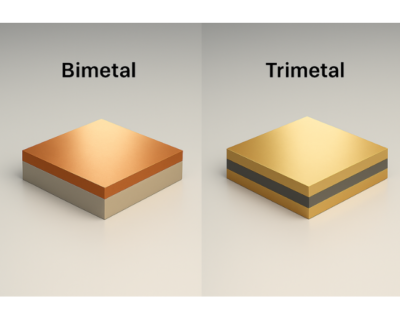Blogs

The Metal That Thinks: A Guide to Thermostatic Bimetals
🔍 What if a tiny strip of metal could sense temperature, react automatically, and control complex systems—without wires, batteries, or programming?
Thermostatic bimetals are one of engineering’s simplest and smartest solutions. Built by bonding two metals with different thermal expansion properties, these strips react to heat by bending—enabling automatic temperature control without electricity, sensors, or software.
Chances are, you’ve used one today without even knowing it. Maybe it was regulating the temperature in your iron, protecting your car’s engine, or ensuring your toaster didn’t overheat. But what is this smart little strip of metal? And why is it so critical to modern engineering?
Let’s begin the journey.
What Is a Thermostatic Bimetal?
At its core, a thermostatic bimetal is a bonded strip made from two metals with different thermal expansion rates. When the strip heats up or cools down, the metals expand or contract at different rates. This difference causes the strip to bend—and that bending can be harnessed to do useful work.
Depending on the setup, a thermostatic bimetal can:
- Open or close an electrical circuit
- Move a valve
- Push a lever or mechanical trigger
All of this happens automatically, passively, and in real-time—no electricity required. It’s an elegant solution for temperature-driven control.
The Simple Science Behind It
Let’s break down the science:
- Imagine a strip made of steel and copper, bonded together.
- When heated, copper expands more than steel.
- As a result, the strip bends toward the steel side.
This motion is small but highly predictable. That makes it perfect for repeatable mechanical actions in everything from electric irons to HVAC dampers.
✔️No batteries
✔️No sensors
✔️Just smart metal physics
✔️No software
Where Is It Used? (Spoiler: Everywhere)
You’ll find thermostatic bimetals in almost every corner of life and industry:

- Home Appliances: They’re the beating heart in irons, toasters, ovens, and kettles—mechanical thermostats that ensure safety and performance.
- HVAC Systems: Automatically trigger fans, heaters, and dampers based on room temperature.
- Automobiles: Found in engine thermostats and radiator fan switches, ensuring temperature control and vehicle safety.
- Electrical Equipment: Critical in circuit breakers and overload protectors, preventing damage from overheating.
- Industrial Equipment: Used in pressure valves, steam traps, and dial thermometers for real-time, passive thermal control.
What You’ll Learn in This Blog Series
This blog is an overview—an introduction to a smart, mechanical material. But we’re just getting started. This blog kicks off a series that dives deep into the world of thermostatic bimetals. Upcoming blogs include:
- How They Work – The science of thermal bending
- Manufacturing Process – From raw metals to finished strips
- Testing Methods – Ensuring durability and accuracy
- Key Properties – What makes them reliable and effective
- Design Guidelines – Tips for smart, efficient use
- Applications – Across home, auto, and industrial sectors
- Features & Benefits – Why they’re a smart choice
Each post will include visuals, diagrams, and practical insights to help you truly understand and apply the principles.
Why This Series Matters
Thermostatic bimetals are more than just clever strips of metal—they are quiet problem-solvers in a noisy, power-hungry world:
- They cut down energy use
- Deliver fail-safe temperature protection
- Enable autonomous responses in places where sensors and wires can’t go
If you’re an engineer, technician, or product innovator, understanding bimetals will help you:
- Make smarter design decisions
- Solve problems with minimal components
- Appreciate the elegant, passive mechanics of materials science
Ready to Dive Deeper?
This was just the introduction. In the next post, we’ll take you inside the bimetal itself—how it bends, moves, and controls with just heat.
🔗 Next Up: How Thermostatic Bimetals Work – A Deep Dive into Smart Motion
👉 Subscribe or bookmark to stay updated.
Have questions or ideas? Drop a comment or get in touch—we’re here to share, solve, and learn.

Talk to: Er.Pankaj Domadia | Kairav Domadia | Aadil Domadia | Pragati Sanap | Pooja N N | Shivani Kanojia




